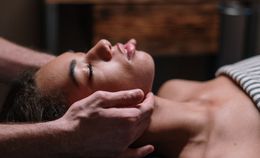A full body massage is a great way to enjoy all the benefits massage therapy has to offer. If you are considering booking a full body massage session for the first time, it's common to feel a little intimidated. Many people feel this way. However, the experience will most likely be the opposite of intimidating or awkward!
Keep in mind that your licensed massage therapist is a professional who is accustomed to working with people in this context. Your massage therapist will almost certainly be glad to answer your questions in advance and let you know what to expect in their specific practice. They will most likely ask you about your goals for the session so that they can tailor their work to best meet your needs and preferences.
That said, having a little information in advance may set your mind at ease and help you get the most out of your full body massage experience. It can also prompt any remaining questions you might have and improve communication with your therapist.
Read on to learn what you will likely encounter in your first full body massage session, as well as some of the health and wellness benefits you are likely to enjoy.
What to expect in a full body massage session
"Full body massage" describes the treatment area for a massage session, but not the type of massage you will experience. There are a variety of types of full body massage available.
If you are new to massage and are not sure what to choose, Swedish massage is a great starting point. It is the most common type of massage available and is appreciated for its relaxing qualities.
Swedish massage incorporates gentle gliding, rhythmic kneading, vibration / shaking movements, friction, and sometimes percussive motions,1 building from lower intensity to deeper pressure, all with constant movement.
Other styles of massage are known for more intense sensations and accessing deeper layers of muscle and tissue. These are great choices if you struggle with pain and lack of mobility in the body. Trigger point therapy, deep tissue massage, shiatsu, Chinese massage, myofascial release, and Thai yoga massage are some examples.
Talk to your massage therapist about your prior experience with massage, your goals for treatment, any pain or tension you may be experiencing, and what kind of massage experience you think you might prefer.
Massage therapists often incorporate a variety of different modalities into their practice, so it is likely you can explore a range of massage styles with the same practitioner. Ask your therapist about their background and training and what types of massage might best meet your needs.
Depending on the style of massage, the practitioner, and your own preference, your full body massage may be given while you are fully clothed, while you are wearing underwear, or while you are nude but draped in a sheet to cover your hips and buttocks. Most women remove their bras to allow massage to the back.
It is a completely normal question to ask a massage therapist what you should wear before a massage, so do not hesitate to ask, and feel free to communicate your preferences if you prefer to remain partially or fully clothed. If you prefer to wear clothing, gym shorts or short leggings are a good choice. A sports bra or bralette is probably the most comfortable option for women who choose not to remove their bra.
Some styles of massage are typically given when a client is fully clothed. These include Thai yoga massage and shiatsu. Loose-fitting clothing such as gym shorts and a t-shirt are a good choice.
It is standard professional practice for a massage therapist to leave the room or draw a curtain while you undress. They may ask you to lie face-down on the massage table before they return.
During the massage, it is okay to talk a bit or to remain quiet. Massage therapists and clients have different preferences about this, and it is good to communicate in advance if you feel strongly one way or another.
It is also normal to experience some soreness or minor discomfort during a massage, but nothing should seriously hurt. You should feel welcome to provide feedback during the session so that your massage therapist can adjust their technique to best serve your needs.
Some people are self-conscious about their bodies and worry about their massage therapist judging them. Remember that massage is meant to support your health and wellness; your massage therapist is a trained professional who likely encounters all kinds of bodies in their practice.
Much like going to the doctor, attending a massage therapy session is about tending to your body and its needs within the context of a professional relationship. You can expect to be treated courteously and to feel safe in this environment.
Health benefits of full body massage
Maybe you've experienced some of the benefits of massage therapy before with a short chair massage, or in a foot reflexology session. If so, you've likely enjoyed a feeling of mental and physical relaxation, relief from muscle aches and stiffness, and greater flexibility and range of motion in your body following the massage.
With full body massage, these benefits can often be more pronounced. That's because the mind and entire body are an interconnected whole. Sometimes massage strokes on one area of the body can have surprising effects elsewhere in the body, as in massage therapy's ability to treat referred pain.2
Referred pain is when a phenomenon in one part of the body causes pain elsewhere, such as a tight, shortened muscle in the forearm that pulls on soft tissues in the hand, causing pain in the fingers.3
Since full-body massage treats the soft tissues of most of the body, it is likely to cover most areas of muscle knots and tightness, scar tissue, etc. that may be responsible for discomfort, stiffness, and pain throughout your body. As a "leave no stone unturned" approach to massage, it is likely to make you feel good in ways you can't anticipate!
Full-body massage is also a great way to reap the psychological health benefits of massage. Massage therapy has been shown to aid in relaxation, reduce blood pressure, reduce feelings of stress and levels of stress hormones and alleviate feelings of anxiety and depression.4 Massage therapy can also help improve sleep and promote positive moods.5
The Bottom Line
Massage therapy can be a wonderful tool for improving your physical and mental health and wellness. As a comprehensive massage treatment, full body massage can be a particularly effective way to maximize the beneficial impacts of massage.
There are a variety of massage types to choose from for a full body massage session. Talk to a licensed massage therapist about your treatment goals and preferences.
Aside from being an effective method for alleviating aches, pains and stiffness, and promoting other positive impacts on your health and well-being, massage therapy is simply a pleasure for most people. Full body massage is an especially great way to reconnect with your body and give your whole mind and body a soothing, nourishing break from everyday stress.
References:
1 "Swedish Massage Techniques - The 5 Steps of Swedish Massage": https://albanymassage.com/swedish-massage-techniques-%E2%80%93-the-5-steps-of-swedish-massage/
2 "Referred Pain": https://www.massagetoday.com/articles/10247/Referred-Pain
3 "Understanding Referred Pain": https://elementsmassage.com/elm-grove/blog/understanding-referred-pain
4 "Massage + Mental Health": https://www.amtamassage.org/articles/1/News/detail/2930/massage-therapy-mental-health
5 "Research Literacy: Massage & Sleep": https://www.amtamassage.org/publications/massage-therapy-journal/research-massage-sleep/





















